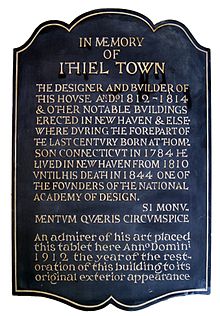Ithiel Town
| Ithiel Town | |
|---|---|

Memorial plaque to Town, Center Church on the Green, New Haven
|
|
| Born |
October 3, 1784 Thompson, Connecticut |
| Died | June 13, 1844 (aged 59) New Haven, Connecticut |
| Nationality | American |
| Occupation | Architect |
| Awards | National Academy of Design; Yale honorary degree |
| Practice | Town and Davis |
| Buildings | Center Church Trinity Church Wadsworth Atheneum |
| Design | Lattice truss bridge |
Ithiel Town (October 3, 1784 – June 13, 1844) was a prominent American architect and civil engineer. One of the first generation of professional architects in the United States, Town made significant contributions to American architecture in the first half of the 19th century. His work, in the Federal and revivalist Greek and Gothic revival architectural styles, was influential and widely copied.
Town was born in Thompson, Connecticut to Archelaus Town, a farmer, and Martha (Johnson) Town. He trained with the eminent Asher Benjamin in Boston and began his own professional career with the Asa Gray House (1810).
His earliest important architectural works include Center Church (1812–1815), and Trinity Church (1813–1816), both on the New Haven Green in New Haven, Connecticut. He demonstrated his virtuosity as an engineer by constructing the spire for Center Church inside the tower and then raising it into place in less than three hours using a special windlass. Trinity Church, built from local seam-faced trap rock and topped with a square tower, was one of the earliest Gothic Revival churches in America.
In 1825, Town became one of the original members of the National Academy of Design and was awarded an honorary Master of Arts degree from Yale University.
On January 28, 1820, Town was granted a patent for a wooden lattice bridge, which became known as the Town Bridge. The design was of great importance because it could be built quickly by relatively unskilled workers from readily available material. The design also avoided the need for the heavy piers needed for stone arches. The design was widely known throughout the world and made Town wealthy (Town is said to have charged one to two dollars per foot in royalties for his designs). Town's design can still be seen in two of Connecticut's remaining covered bridges, Bull's Bridge in Kent and West Cornwall Covered Bridge in Cornwall and Sharon, and in the Eagleville Bridge and the Shushan Bridge in Washington County, New York. Many other extant covered bridges also employ Town's basic design. The lattice is sometimes called a truss, although it lacks vertical members.
...
Wikipedia
